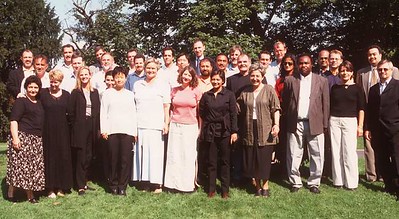
20 years ago this week, an incredible opportunity came my way, out of the blue: I was invited to Germany by a program of the United Nations, to be a part of a group exploring how information communications technologies – ICTs, computers, PDAs, and the Internet – were transforming communities all over the world and the role volunteers played in supporting and expanding the use of ICTs to support a whole range of activities: health education, agriculture, governance, small business development and more (ICT4D).
This is from the original United Nations communications about this event:
Close to 30 experts in development and information and communication technologies (ICTs) met for a workshop from 21 to 23 August at the headquarters of the United Nations Volunteers programme (UNV) in Bonn, Germany, to discuss ways how volunteers can assist developing countries in the application of ICT to human development. Representing a wide range of organizations from all over the world, the workshop participants focused their discussions on how to launch operations of the United Nations Information Technology Service (UNITeS), a volunteer initiative to help bridge the digital divide. UN Secretary-General Kofi Annan asked UNV to take the lead in bringing together a coalition of partners to launch the new initiative, which was announced in April.
I was invited to participate because I was directing the Virtual Volunteering Project at the University of Texas at Austin, and was frequently posting to various online communities about working with online volunteers and how volunteers were participating in various community technology initiatives. A UNV staff member saw my posts on a group called CYBERVPM and some other online communities, passed on my information to another staff member looking for advice, and the rest is history.
The role volunteers have played in helping people use online technologies cannot be under-estimated. Volunteers were the primary staffing for most community technology centers and nonprofit Internet cafés, helping people to get their first email address, surf the web and find essential information. The Community Technology Network, ctcnet.org, compiled best practices from community tech centers all over the world, sharing these on their web site for anyone to access – you can see these resources yourself by going to The Internet Wayback Machine and looking for www.ctcnet.org yourself.
Because of this invitation, my life changed forever: at the end of the event, held at the headquarters of the United Nations Volunteers program, I was invited to apply for a new position that was being created at UNV to manage the online volunteering part of NetAid, which I later successfully moved entirely to UNV and it became the Online Volunteering Service, I also co-managed the United Nations Technology Information Service (UNITeS), the Secretary General’s ICT4D initiative born out of this meeting – it was a global initiative to help bridge the digital divide that both supported volunteers applying information and communications technologies for development (ICT4D) and promoted volunteerism as a fundamental element of successful ICT4D initiatives.
And from there began my work in international humanitarian and development work: I stayed at UNV for four years, got my MSc in Development Management in December 2005, worked in Afghanistan and Ukraine with UNDP, stayed based in Germany for eight years, and continued to work internationally even after moving back to the USA in 2009.
20 years. It’s just so hard to wrap my head around it being two decades since this happened. I will always be grateful for the circumstances and people that earned me the invitation to this meeting. I will always be grateful to have had these 20 years since.
I’m the girl in the peachy/pink shirt in the middle of this photo, by the way… if you are in the photo, please comment below!
Also see:
- Jayne, how did you get to work for the UN?!.
- United Nations Tech4Good / ICT4D Initiatives
- Frank description of what it’s like to work in communications in the UN
- what aid workers can learn in their home countries to use abroad (& vice versa)
- Is it really *impossible* to break into humanitarian work?
- Isn’t my good heart & desire enough to help abroad?
- Problems in countries far from home can seem easy to solve
- How to Get a Job with the United Nations or Other International Humanitarian or Development Organization
- Career consulting for people seeking to work in humanitarian-related fields

OMG 20 years already!!! It was great meeting you and I still have vivid memories of the workshop sessions, the great discussions and the fun times! I didn’t know yet that just a few months later I would leave as a UNITes vounteer… this marked the begining of an entire new and exciting life. Little didI I know then that years later I’d bump (with immense pleasure) into you in Kabul…! I do hope to bump into you again somewhere, sometime! Thanks for all the cool stuffyouwrite and share, and thanks for keeping in touch for the past 2 decades!!!
Oh, Sonia, I am SO glad you wrote! You are one of the very first people I met at UNV. You were a fantastic meeting facilitator and friend. And the only person I’ve ever known who has been to Bhutan! I just know I’m going to look across a room again in some exotic location and you will be there….